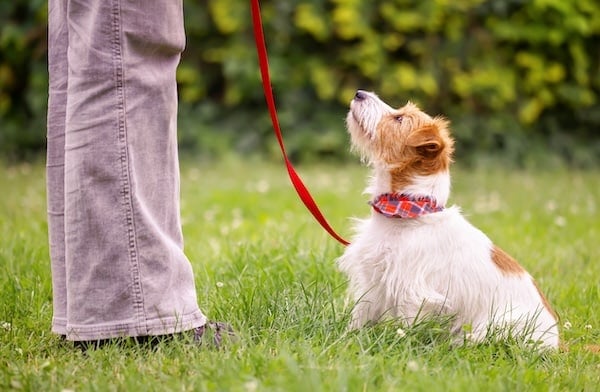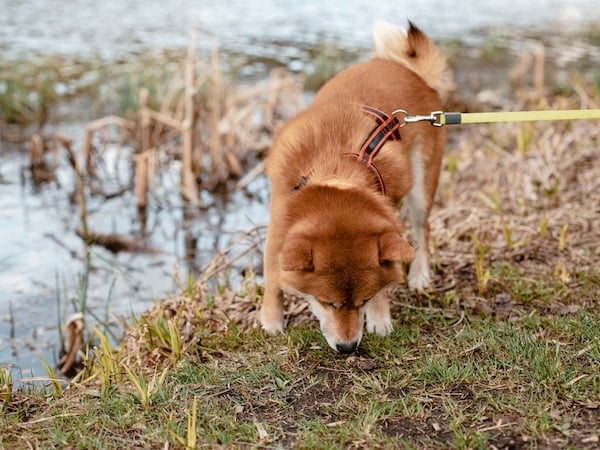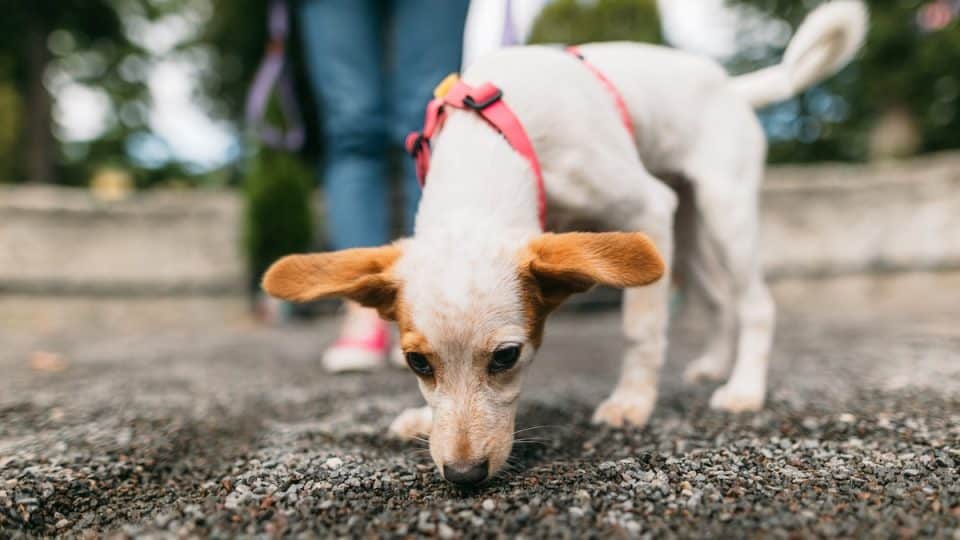- Not a substitute for professional veterinary help.
Walking a dog offers more than just exercise. It’s a chance to add enrichment and mental stimulation to a pup’s life. Regular walks also encourage bonding, reinforce training, and let your dog explore the world around them.
But there’s more to a successful dog walk than just leashing up and heading out. It also involves understanding your dog’s needs, choosing the right walking gear, and being courteous to fellow walkers.
To help you make the most of your dog’s walks, we consulted two certified positive reinforcement trainers: Carly Clarke, owner of Super Woofers Puppy & Dog Training, and Melissa Robinson, founder of Paws + Praise Positive Reinforcement Dog Training. Whether you’re an old hand or new to dog parenthood, this guide is packed with tips to make each outing enjoyable, meaningful, and safe.
Types of Dog Walks
Did you know that dog walks can serve different purposes? Mixing up the types of walks you take with your pooch can ensure they’re happy and fulfilled. Here are some popular options to try.
- Exercise walks. The goal here is to get your dog moving and burn off energy. Increase the pace and cover more distance for a great workout. Or go hiking, teach your pup to run with you, or try skijoring for a fun jaunt together.
- Training walks. Use this time to reinforce obedience and leash manners. During training-focused walks, you can practice cues and loose-leash walking to keep your dog’s mind active.
- Decompression walks. These are relaxing dog-led walks on a long line where your pup can sniff and explore as they wish.
- Exploratory walks. Taking different routes keeps walks exciting. “Dogs thrive on novelty, so taking them to a new park or trail can turn an ordinary walk into an adventure,” says Clarke.
- Socialization walks. Ideal for puppies, these walks expose your dog to different environments, people, and dogs. When socialization is the primary goal, try walking your dog past different sights and sounds.
- Potty walks. Short and to the point, these walks let your dog relieve themselves.
What To Avoid
Walking your dog should be a mutually positive experience, but a few common mistakes can make strolls less enjoyable. Here’s what to avoid.
- Not letting your dog sniff. Dogs experience the world through their noses. Not only is sniffing mentally stimulating for dogs, but it helps tire them out! Even if you’re not on a sniff-focused decompression walk, trainer Melissa Robinson suggests letting your dog sniff for the first few minutes after leaving your home.
- Choosing busy routes. Robinson recommends walking in quieter areas where your dog can relax and enjoy the scenery without feeling overwhelmed by noise or crowds.
- Sticking to the same route. Repeating the same walk every day can be boring for your dog. Robinson encourages pet parents to explore new places with their dogs, exposing them to new sights, sounds, and smells. Variety helps with socialization and mental enrichment.
- Forgetting to reward good behavior. According to trainer Carly Clarke, if you only pay attention when your dog misbehaves, you miss opportunities to reinforce positive behavior. Reward your dog with treats when they’re calm and walking on a loose leash beside you.
- Ignoring your dog’s energy level. Walks should reflect your dog’s ability and stamina. Tailor the length and intensity of your outings to your dog’s breed, age, and energy.
- Being distracted by your phone. Engaging with your dog during walks strengthens your bond. You can also avoid distractions (and accidents) by putting your phone away.
- Using harmful gear. Avoid aversive tools like shock or prong collars, which can hinder training progress. Even safe tools, like head collars and no-pull harnesses, can become harmful if misused—so take a minute to make sure walking gear is properly fitted and you know how to use it safely.

Wavetop via iStock
What To Do
Now that you know what to avoid, our experts have outlined some practical dog-walking tips for better adventures.
Play attention games
“Dogs are pros at ignoring us when the world is more exciting,” explains Clarke. “[Attention games] teach dogs that checking in with you is always worth it.”
Start by holding a handful of treats and drop one on the ground. When your dog finishes eating and looks back at you, mark the behavior with a “yes” or a click, then drop another treat. This encourages a habit of checking in with you, even when there are interesting distractions nearby.
Encourage good behavior with positive reinforcement
“Walks are the perfect time to reinforce good behaviors,” says Clarke, adding that positive reinforcement keeps your dog engaged and motivated. Always carry treats to reward your dog when they walk calmly or check in with you unprompted. (A good treat pouch can help!)
Try working on cues like “stay,” “leave it,” and “heel” during your stroll to keep your dog focused and engaged. You can also practice sitting and waiting patiently to cross roads. This makes walks mentally stimulating, keeps your pup attentive, and strengthens your relationship.
Watch your dog’s body language
Robinson emphasizes the importance of watching your dog’s body language on walks. “Pet owners often miss signals that their dog wants to stop, explore, or is feeling scared or anxious,” she explains.
A happy dog will usually have loose, bouncy movements and a wagging tail. But an anxious or fearful dog might have a tucked tail, whale eyes, and a tense smile while panting. If your dog appears distressed, calmly steer them away from whatever is triggering their discomfort.
Practice proper greeting etiquette
Being considerate on walks isn’t just about being polite—it helps keep everyone safe. To navigate leash greetings when you meet other people or dogs, always prioritize your own dog’s comfort. If your pup is shy or reactive, it’s perfectly fine to avoid interactions and advocate for their space. You don’t owe anyone a meeting.
The same goes for other dogs—always ask the other pet parents before letting your dog approach.
Work on curbing pulling
Managing a dog who pulls can be tricky, but there are effective strategies to help. First, show your dog that staying close to you on leash is super rewarding. Any time they’re next to you, mark the behavior with a “yes” or a click. You can also try the leash pressure game, which trains them to come back to you when they hit the end of the leash.
On wider trails, consider using a longer leash to give your dog more room to move. Pre-walk playtime and exercise can also burn off extra energy and curb pulling.
Be prepared for the weather
Dogs have varying tolerances for heat, cold, and humidity. It’s important to consider your dog’s breed and coat type before heading out. To lower the risk of burnt paw pads or heatstroke, Robinson advises against walking on very hot summer days (over 80℉).
In colder weather, stay safe by watching for ice and salt on sidewalks. You can also dress your dog for the elements using a raincoat, parka, or protective booties.
Use the right gear
When choosing a leash, it’s critical to get the proper length. A standard 6-foot leash often works well for general training and short neighborhood walks. For more rural adventures, you might want a longer lead. “A short lead might feel like it gives you more control, but it doesn’t give your dog the freedom they need to sniff and explore,” explains Clarke.
Generally, harnesses are safer and more comfortable for walks than a collar. When picking a harness, find one that meets your dog’s specific needs, whether they’re a puller, a giant breed, or an escape artist.
End the walk early if necessary
Dogs have different exercise needs and attention spans, and sometimes a short walk is better than a long one. Some dogs will overexert themselves, appearing happy and content when they’re actually tired. If your dog shows signs of fatigue, it’s time to head home. After all, the quality of the walk matters more than the distance.
Games To Help Your Dog Walk Nicely
Incorporating games into your training can help make walks more fun. Shoshi Parks, Ph.D., a dog trainer at Modern Hound, suggests these two fun games to encourage polite walking and redirecting your dog’s focus back to you.
The name game
This game reinforces your dog’s response to their name and builds engagement during your walks. Here’s how to play.
- Start by saying your dog’s name in a cheerful tone while you walk.
- When your dog looks at you, say “yes” or click and give them a treat, all while keeping the pace.
- Repeat the process, aiming for five repetitions every block.
- Gradually reduce the frequency until you say their name one time per block.
As you do this, Parks says your dog should continue glancing back at you, even without prompting. Don’t forget to mark and reward those look-backs!
Touch targeting
This game uses hand-targeting to keep your dog close without pulling. Think of your hand as a magnetic force pulling your dog back to you.
- Make sure your dog knows a solid “touch” cue first.
- If they start to pull, hold out your hand at your side and ask for a “touch.”
- When their nose meets your hand, say “yes” and mark with a click and treat them—all while walking.
- Repeat as needed to reinforce the behavior.

Alina Nikitaeva via iStock
What Are Your Dog Walk Goals?
Ultimately, walks aren’t just about walking—they’re about letting your dog be a dog! From sniffing and exploring to learning and socializing, walks fulfill various needs and provide an outlet for natural dog behaviors.
Don’t fret if some walks aren’t super long or strenuous—quality trumps quantity. “The perfect dog walk isn’t just about steps or distance,” says Clarke. “It’s about enrichment for both you and your dog.”
For your dog, a fulfilling walk could mean following enticing scents, discovering new environments, or practicing cues. For you, it can be a time to unwind in nature.
Clarke emphasizes that the best walks will strike a balance. “You set the structure, but your dog gets the freedom to be, well, a dog.”



